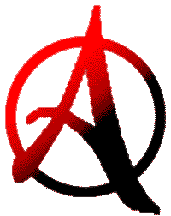
 Mark-up by the
Mark-up by the
P o r t l a n d * A n a r c h i s t
W e b * P a g e s



Anarchism has always stood deliberately for a broad, and at times vague, political platform. The reasoning is sound; blueprints create rigid dogma and stifle the creative spirit of revolt. Along the same lines and resulting in the same problems, Anarchist s have rejected the "disciplined" leadership that is found in many other political groupings on the Left. The reasoning for this is also sound; leadership based on authority is inherently hierarchical. It seems to follow logically that since Anarchists ha ve shied away from anything static, that they would also shy away from the importance of symbols and icons.
While this is may be an explanation of why the origination of Anarchist symbols is elusive and inconclusive, the fact is, Anarchists have used symbolism in their revolt against the State and Capital, not only the black flag, but also the circle-A. Circle- As are spray-painted on walls and under bridges all over the world; punks display them on their jackets and scrawl them into half-dried cement. Black flags have recently been resurrected in Russia and continue to fly in most parts of the world.
There are ample accounts of the use of black flags by anarchists. Probably the most famous, was Nestor Makhno's partisans during the Russia Revolution. Under the black banner, his army routed a dozen armies and kept a large portion of the Ukraine free fro m concentrated power for a good couple years. More recently, Parisian students carried black (and red) flags during the massive General Strike of 1968.
Not long after, the black symbol made it's way to America. Paul Avrich reports that on November 27, 1884, the black flag was displayed in Chicago at an Anarchist demonstration. According to Avrich, August Spies, one of the famous Haymarket martyrs, "noted that this was the first occasion on which [the black flag] had been unfurled on American soil" (Avrich, The Haymarket Tragedy, 144-145).
On a more dreary note, February 13, 1921 was the date that marked the end of black flags in Soviet Russia. On that day, Peter Kropotkin's funeral took place in Moscow. Masses of people whose march stretched for miles, carried black banners that read, "Whe re there is authority there is no freedom" (Avrich, The Anarchists in the Russian Revolution, 26). It seems that black flags didn't appear in Russia until the founding of the Chernoe Zhania ("black banner") movement in 1905. Only two weeks after Kropotkin 's funeral march, the Kronstadt rebellion broke out and anarchism was erased from Soviet Russia for good.
While the events above are fairly well known, as has been related, the exact origin of the black flag is not. What is known is that a large number of Anarchist groups in the early 1880s adopted titles associated with black.
In July of 1881, the Black International met in London. This was an attempt to reorganize the Anarchist wing of recently dissolved First International. Similarly, there was the Black Band in France (1882) and the Mano Negra (Black Hand) Andalusia, Spain ( 1883). These dates are immediately followed by Michel's demonstration (1883) and the black flags in Chicago (1884).
Further solidifying this period (circa early 1880s) as the birth of the symbol is the name of a short lived French Anarchist publication: "Le Drapeau Noir" (The Black Flag). According to Roderick Kedward, this Anarchist paper existed for a few years datin g sometime before October 1882, when a bomb was thrown into a cafe in Lyons (Kedward, 35). Backing up this theory, Avrich states that in 1884, the black flag "was the new anarchist emblem" (Avrich, The Haymarket Tragedy, 144). In agreement, Murray Bookch in reports that "in later years, the Anarchists were to adopt the black flag" when speaking of the Spanish Anarchist movement in June, 1870 (Bookchin, 51n1). At that time, anarchists widely used the red flag. It appears obvious (though not conclusive) tha t this is the period that the black flag bonded with Anarchism.
Along these lines, Albert Meltzer maintains that the association between the black flag and working class revolt "originated in Rheims [France] in 1831 ("Work or Death") in an unemployed demonstration (Meltzer, 49). In fact he goes on to assert that it wa s Michel's action in 1883 that solidified the association. But there are other possibilities.
Black is a very powerful color, or anti-color as it were. The 1880s were a time of extreme anarchist activity. The Black International saw the introduction of "propaganda of deed" as an anarchist platform. Historically black has been associated with blood -- dried blood specifically -- like the red flag. So while it is tied to working class rebellion, it was also a symbol of the nihilism of the period.
Pirates were seen as rebels, as free spirits, and often ruthless killers. While pirates varied a great deal, many had an elected Captain of the pirate ship. In some cases the captain wasn't even male, which was very unusual for the time. He or she was "su bject to instant recall", and life on board a pirate ship was certainly more democratic than life on board ships of the British, American or French Navies -- let alone a merchant ship.
For pirates, the black flag was a symbol of death; the give-away being a skull and bones on black. A sign equivalent with "surrender or die!" It was intended to scare their victims into submitting without a fight. It operated in much the same way as Gheng is Khan's armies.
Many others also adopted the black flag as a sign of "surrender or die!". A Confederate officer named Quantrill in during the American Civil War fought under the black flag. He was known as unwilling to show mercy to his opponents and he did not expect an y mercy in return. Also, General Santa Anna of Mexico was a notorious flyer of the black flag. He even flew them at the Alamo. Accompanying the black banner, he had his buglers play a call named "The Deguello," which was a call that meant "no quarter will be given" (Take No Prisoners).
While Khan, Quantrill and General Santa Anna are not connected to anarchism in the slightest -- pirates, on the other hand, are more complicated. They were seen as rebels. Rebels without a state, owing allegiance to no code of law except whatever makeshif t rules they improvised amongst themselves. Certainly pirates were not consciously anarchist, and often acted no better than barbarians. But what is important is how they were seen. Their symbol was the embodiment of rebellion and the spirit of lawlessnes s and rebellion. They were hated by the ruling class.
This may have been enough for the starving and unemployed to pick up the black flag in revolt. In fact, one could quickly get ahold of a piece of red or black cloth in a riot. Getting hold of the material was easy. Painting a complicated symbol on it took time. So an improvised rebel flag raised in a riot was likely to be of just one color. Hence it follows nicely that the black flag flew without the skull and bones because it was necessarily make-shift for a riot.
To this question of the black flag, Howard Ehrlich has a great passage in his book Reinventing Anarchy. It is worth quoting at length:
"Why is our flag black? Black is a shade of negation. The black flag is the negation of all flags. It is a negation of nationhood which puts the human race against itself and denies the unity of all humankind. Black is a mood of anger and outr age at all the hideous crimes against humanity perpetrated in the name of allegiance to one state or another. It is anger and outrage at the insult to human intelligence implied in the pretenses, hypocrisies, and cheap chicaneries of governments."Black is also a color of mourning; the black flag which cancels out the nation also mourns its victims the countless millions murdered in wars, external and internal, to the greater glory and stability of some bloody state. It mourns for those whose labo r is robbed (taxed) to pay for the slaughter and oppression of other human beings. It mourns not only the death of the body but the crippling of the spirit under authoritarian and hierarchic systems; it mourns the millions of brain cells blacked out with never a chance to light up the world. It is a color of inconsolable grief.
"But black is also beautiful. It is a color of determination, of resolve, of strength, a color by which all others are clarified and defined. Black is the mysterious surrounding of germination, of fertility, the breeding ground of new life which always ev olves, renews, refreshes, and reproduces itself in darkness. The seed hidden in the earth, the strange journey of the sperm, the secret growth of the embryo in the womb all these the blackness surrounds and protects.
"So black is negation, is anger, is outrage, is mourning, is beauty, is hope, is the fostering and sheltering of new forms of human life and relationship on and with this earth. The black flag means all these things. We are proud to carry it, sorry we hav e to, and look forward to the day when such a symbol will no longer be necessary."

Paul Avrich, "The Haymarket Tragedy", Princeton University Press, 1984.
Murray Bookchin, "The Spanish Anarchists: The Heroic Years 1868-1936", Harper Colophon Books, 1977.
Roderick Kedward, "The Anarchists: the men who shocked an era", American Heritage Press, 1971.
Albert Meltzer, "The Anarcho-Quiz Book", Black Flag (organ of the Anarchist Black Cross), 1976.
George Woodcock, "Anarchism: A History of Libertarian Ideas and Movements", Penguin Books, 1963.

 Mark-up by the
Mark-up by the
P o r t l a n d * A n a r c h i s t
W e b * P a g e s
